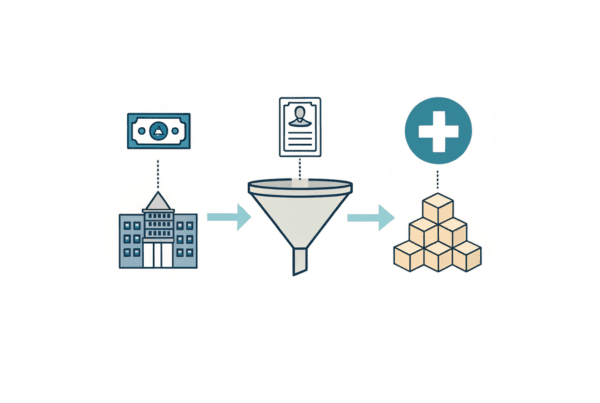Selling your Sports Medicine and Performance Therapy practice in New York City is a significant decision. The current market presents a strong opportunity, but realizing your practice’s full value requires careful preparation and an understanding of what buyers are looking for. This guide provides key insights into the NYC market, the valuation process, and the steps involved in a successful transition, helping you navigate the path from consideration to a successful closing.
The NYC Market: An Overview
The environment for selling a specialty practice like yours is strong. This is driven by broad demographic trends and specific local dynamics that make New York City a focal point for healthcare investment.
A Growing National Trend
Nationally, the demand for physical therapy and performance services is surging. The market is projected to grow from $27 billion in 2022 to nearly $49 billion by 2032. This reflects an aging population dedicated to staying active and a younger generation focused on performance optimization and injury prevention. This sustained growth makes practices in this vertical highly attractive to buyers looking for stable, expanding investments.
The New York City Advantage
In a competitive landscape like New York City, a well-run Sports Medicine and Performance Therapy practice is a prime asset. NYC’s dense, high-income population provides a rich patient base willing to pay for specialized, high-quality care. This makes the city a priority market for large health systems and private equity groups looking to establish or expand their footprint. For a practice owner, this means your location itself adds significant value and attracts a wider pool of potential buyers.
Key Considerations for NYC Owners
When you run a practice in a city like New York, the stakes are higher. Your patients have high expectations, and your reputation is a core part of your value. Before a sale, it is important to consider how dependent the practice is on your personal brand versus a scalable, team-driven model. Buyers in NYC are sophisticated. They will analyze your patient demographics, referral sources, and your clinic’s position against competitors. A successful sale depends on telling a compelling story backed by clean data that showcases not just your current success, but a clear path for future growth under new ownership.
3 Trends Driving Market Activity
The high demand for quality practices is not just theoretical. We see clear trends in the types of buyers actively pursuing acquisitions in New York City.
- The Rise of Private Equity. Private equity (PE) firms are increasingly investing in specialty medical fields. They are drawn to the cash-pay potential and recurring revenue of performance therapy. They seek to acquire “platform” practices with strong leadership and growth potential, which they can then use as a base to acquire smaller clinics.
- Strategic Consolidation. Large regional therapy groups and hospital systems are also on the acquisition trail. Their goal is to expand their service lines and capture a larger share of the patient market in key zip codes. A well-located sports medicine practice can be the perfect addition to their network.
- The Premium on Performance. In today’s market, buyers are not just looking for practices. They are looking for well-oiled machines. Practices with efficient operations, a diverse team of providers, and clean financial records are receiving premium valuations because they represent less risk and a clearer path to a return on investment.
The Sale Process in Practice
The path to selling your practice is a structured journey, not a single transaction. It begins long before you speak to a potential buyer, with thorough preparation of your financial and operational documents. The next critical step is establishing a credible valuation to anchor negotiations. From there, a confidential marketing process is run to identify and engage a curated list of qualified buyers. This leads to negotiating offers, selecting the right partner, and navigating the intensive due diligence phase where the buyer verifies every aspect of your practice. Each stage presents opportunities and potential pitfalls. Managing this process correctly is key to protecting your confidentiality and achieving the best possible outcome.
What Is Your Practice Really Worth?
One of the most common mistakes owners make is underestimating their practice’s true worth. Your tax return shows one story, but sophisticated buyers value your practice based on its actual cash flow, known as Adjusted EBITDA. This process involves “normalizing” your financials by adding back one-time costs and personal expenses run through the business.
For example, an owner’s salary above the market rate, a vehicle lease, or personal travel can all be added back to your bottom line. This reveals the true profitability a new owner could expect.
| Financial Metric | Reported on P&L | Adjusted for Sale |
|---|---|---|
| Net Income | $400,000 | $400,000 |
| Add-Back: Owner Salary above market | – | + $100,000 |
| Add-Back: Personal expenses | – | + $25,000 |
| Adjusted EBITDA | $400,000 | $525,000 |
This adjusted figure is then multiplied by a factor (a “multiple”) that reflects your practice’s size, growth rate, and stability. A higher Adjusted EBITDA directly translates to a higher valuation. An accurate, defensible valuation is the foundation of any successful sale.
Planning for Life After the Sale
A successful transition is defined by what happens after the papers are signed. The structure of your deal has major implications for your team, your personal role, and your financial future.
Protecting Your Team and Legacy
For most owners, the practice is more than a business; it is a legacy. Finding a buyer whose culture aligns with yours is important for ensuring your team is taken care of and your patients continue to receive excellent care. The right partner will see your staff as a key asset, not an expense to be cut.
Structuring Your Next Chapter
A sale does not have to mean an immediate exit. Many deals are structured to keep the owner involved for a transition period, often with significant upside. This can include an “equity rollover,” where you retain a portion of ownership in the new, larger entity, giving you a potential second financial gain when that entity sells in the future. This approach allows you to secure your financial future while staying involved in the work you love.
Optimizing Your Financial Outcome
The check you receive at closing is not your final take-home amount. The way a deal is structured has massive tax implications. Planning ahead with advisors who understand healthcare M&A can help shape a transaction that maximizes your post-tax proceeds, ensuring the rewards of your life’s work are fully realized.
Frequently Asked Questions
What makes New York City a unique market for selling a Sports Medicine & Performance Therapy practice?
New York City offers a dense, high-income population that provides a rich patient base willing to pay for specialized, high-quality care. The city’s competitive healthcare landscape attracts large health systems and private equity groups, increasing the value of well-run practices.
How is the value of a Sports Medicine & Performance Therapy practice in NYC typically determined?
The practice’s value is primarily based on its Adjusted EBITDA, which normalizes financials by adding back one-time costs and personal expenses. This figure is multiplied by a factor reflecting the practice’s size, growth rate, and stability to determine the final valuation.
What should owners in NYC consider about their practice before selling?
Owners should consider how much the practice relies on their personal brand versus a scalable team-driven model. Buyers analyze patient demographics, referral sources, and competitive positioning. A clear growth path under new ownership supported by clean data is crucial for a successful sale.
Who are the typical buyers interested in acquiring Sports Medicine & Performance Therapy practices in NYC?
Typical buyers include private equity firms attracted by cash-pay potential and recurring revenue, large regional therapy groups, and hospital systems aiming to expand service lines and patient capture in key areas.
What post-sale considerations should practice owners in NYC keep in mind?
Owners should focus on protecting their team and legacy by finding buyers with compatible cultures, consider deal structures that allow them to stay involved via mechanisms like equity rollovers, and plan for tax implications to optimize financial outcomes after the sale.



